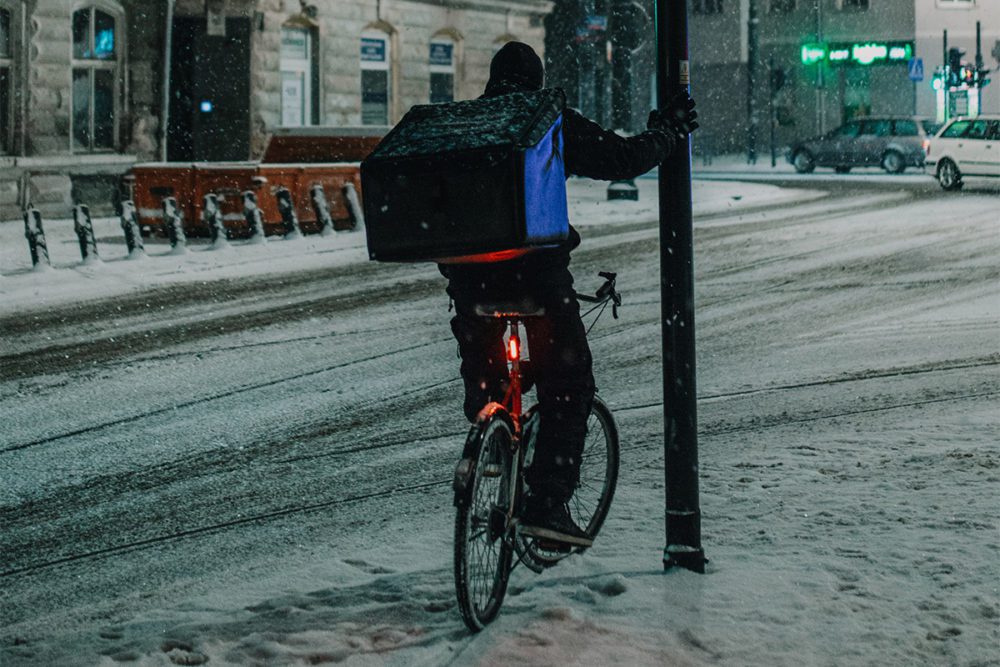How to keep commuting by bike throughout winter

Whether it’s five miles or fifteen, riding to work once the clocks go back can seem somewhat unappetising. But riding to work through winter can be a rewarding experience if you’re prepared. We’ve put together a few pointers to help you keep commuting by bike this winter.
Make sure you have a good set of lights
Now the clocks have changed, it’s unlikely you’ll miss the dark on at least one side of your commute. With this in mind, as well as being a legal requirement, your lights are no longer just there for you to ‘be seen’. It’s important to have a good set of lights that will not only make you visible to other road users, but ensure you can see in front of you in the dark. Look for USB rechargeable lights and don’t forget to charge them! If funds allow, consider buying a spare pair in case one light fails, so you’ll never be left in the dark.
Invest in decent luggage
If you place value in the things you take to work, then invest in a decent bit of luggage. Whether that be panniers or a rucksack, there are plenty of options that will protect your belongings from the elements. Look for taped seams for extra water resistance. You can even buy luggage in hi-viz or reflective material if you want to make sure you really stand out.
Ride more assertively
You shouldn’t hug the kerb at any time of year, but throughout winter this is especially important if you want to avoid punctures. Debris – regular grit and gravel, as well as the general wear and tear from motor vehicles – is swept towards the sides of the roads, and during winter it gets even worse thanks to the weather and increased road use. Additionally, drain covers are notoriously slippery when it’s cold or wet, so stay safe by keeping your distance from the kerb.

Wrap up warm, but not too warm
This depends on how long your commute is and just how cold it gets outside. The key is finding that magic number of layers so you neither freeze nor overheat. If you wear regular clothes on your ride in, consider some waterproof over-trousers, or even water-resistant jeans. You don’t need to spend hundreds of pounds to be comfortable this winter but look for a decent base layer (we like merino wool), and a water-resistant jacket. For your bottom half, if you’re a fan of lycra, a decent set of winter bib tights will be a good investment. Overshoes are also a good idea, so your feet don’t get totally soaked when it rains.
Yellow Jersey customers receive a 20% discount off of Proviz cycle apparel, go to your dashboard to get your exclusive discount code and check out their wears here.
Prepare for wet clothes to ride home in
Sometimes there’s just no avoiding riding home in damp socks, but if you can, see if you can scout out a spot at work to hang your wet kit. If you don’t fancy subjecting your colleagues to your musty bib-tights, consider leaving a spare set of kit, socks especially, at work.
Ride with the conditions
You don’t need to be a hero. The danger with dropping temperatures is the risk of black ice, that ice you can’t see until you’re on your backside. So if the temperature is low, make sure you take it steady, but if it’s too icy, don’t risk it. Get the bus. Additionally, if it’s really wet, remember your brakes will take longer to stop. So if it’s lashing it down, ride a little slower to account for the extra time you’re going to need. Potholes are also likely to be hiding under puddles, so just take your time and ride safe.
Consider changing your tyres
If you have the frame clearance, consider switching from summer tyres to something a little wider, say 28mm or more if your bike will take it. The wider tyre allows you to drop the pressure a little, giving you slightly more comfort and grip. The staple tyre choice for winter road bike tyres are the Continental Gatorskins or the Schwalbe Marathon Plus tyres which should see you through the winter season, puncture free. You could also maximise your chances by going tubeless, just ask your local bike shop and they will hook you up.
Make sure you’re covered this winter for any accidents or theft. Have a look at our policies here.







